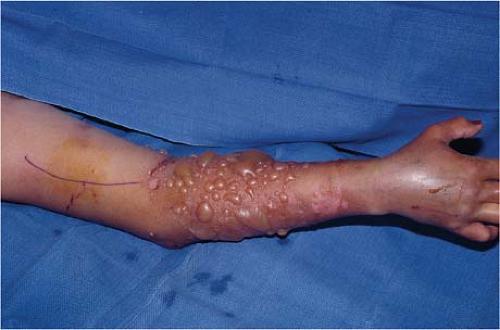Fasciotomies for Forearm and Hand Compartment Syndrome
Jeffrey B. Friedrich
Alexander Y. Shin
Indications/Contraindications
Indications
The chief indication for forearm and/or hand fasciotomies is essentially any suspicion that the patient has a forearm or hand compartment syndrome. The diagnosis of upper extremity compartment syndrome is made with a combination of clinical examination and objective diagnostic measurements. The clinical examination findings for upper extremity compartment syndrome traditionally have been taught as the five “P’s” which include pain in the forearm and hand, increased pain with passive extensive extension of the fingers, pallor, pulselessness, and paresthesias. However, one must note that not all of these criteria need be present to determine that a patient has compartment syndrome. In fact, pulselessness can be a very late or nonexistent finding in the patient who has a compartment syndrome. Therefore, reliance on these five P’s should also be balanced with other clinical examination findings as well as objective diagnostic findings. In addition to the criteria mentioned, the forearm and hand suffering from compartment syndrome will typically be very tense and swollen and can often have signs of trauma from the inciting injury, if that is the cause of the compartment syndrome. Skin changes such as blistering and a “shine” due to significant swelling are common findings as well (Fig. 12-1).
Compartment syndrome can be caused by extrinsic pressure such as casts or splints, and this possibility should be factored into the diagnostic algorithm. The first step in evaluation with a patient who is in a cast or splint is removal or loosening of the immobilization device. Other scenarios in which the physician should suspect the development of compartment syndrome include crush injuries, supracondylar humerus fractures, two-bone forearm fractures, and any situation where there has been a period of ischemia followed by reperfusion, such as brachial arterial injury, upper arm replants, or a comatose patient who has been found with the arm in compression.
Objective data are obtained to help corroborate the diagnosis of compartment syndrome, usually in the form of intracompartmental pressure measurements. These can be taken by a variety of techniques including saline infusion pressure transducers, slit or wick catheters, or even arterial pressure monitors. There are newer diagnostic tools to diagnose compartment syndrome including near-infrared spectroscopy, electromyography, myotonometry, and laser Doppler; however, these modalities are, at this point, experimental and can only be used as correlative measures at best.
If compartment syndrome is suspected, it is essential that intervention be implemented quickly to lessen injury to the underlying muscles and nerves. Increased pressure on muscle can lead to irreversible ischemia and eventual necrosis. Late sequeli of untreated compartment syndrome of the forearm produces contractures of the volar forearm commonly known as Volkmann’s ischemic contracture.
In general, prompt administration of surgical decompression of the forearm compartment will adequately treat the forearm compartment syndrome and leave a patient with minimal residual dysfunction.
In general, prompt administration of surgical decompression of the forearm compartment will adequately treat the forearm compartment syndrome and leave a patient with minimal residual dysfunction.
Contraindications
While one can argue that hemodynamic instability would be a relative contraindication to upper extremity fasciotomies, it is recommended that this not be viewed as an absolute contraindication, and that once the patient is stabilized, the surgical team proceeds with forearm and/or hand fasciotomies at the earliest available time. In the worst-case scenario, fasciotomies can be performed at the bedside in the intensive care unit. In general, upper extremity compartment syndrome is an emergency and there should be no absolute contraindications to this procedure.
Preoperative Planning
When planning for surgical intervention for upper extremity compartment syndrome, the previously mentioned diagnostic modalities should be used to document increased forearm or hand pressures. In addition, if it is thought that the patient has developed a compartment syndrome in the setting of external compression including splints or casts, these devices should be loosened or removed immediately to help diagnose the cause of the patient’s symptoms as well as provide some measure of relief from the compressive insult. Often, the removal or loosening of a cast can provide adequate treatment; but even if the patient does show resolution of symptoms, practitioners are encouraged to remain vigilant and continue to closely monitor the patient’s extremity until there has been a total resolution in symptoms. Other planning should include early notification of anesthesia and operating room staff and the availability of blood for transfusion if it is indicated during the surgical procedure.
In some cases coagulopathy can contribute to or be the sole cause of compartment syndrome. Excessive bleeding following fracture reduction or continued bleeding following surgery can lead to increased compartmental pressures. If a bleeding dyathesis is suspected, appropriate steps should be taken to correct the deficiency before operative intervention.
Surgery
Patient Positioning
Once anesthetized, the patient should be positioned in a way that affords adequate access to the entire affected upper extremity for both surgeon and assistant. This includes turning the operating table at a right angle to the anesthesia provider and placing the affected upper extremity on an arm board that is attached to the operating room table. Good lighting is essential, especially because the viability
of the muscles in the forearm and hand needs to be assessed at the time of fasciotomy. While pneumatic tourniquets are frequently used for upper extremity surgery, they should not be used for a forearm fasciotomy because, as stated previously, the perfusion of the affected forearm musculature must be assessed at the time of fasciotomy.
of the muscles in the forearm and hand needs to be assessed at the time of fasciotomy. While pneumatic tourniquets are frequently used for upper extremity surgery, they should not be used for a forearm fasciotomy because, as stated previously, the perfusion of the affected forearm musculature must be assessed at the time of fasciotomy.
Technique for Fasciotomy of Forearm
Stay updated, free articles. Join our Telegram channel

Full access? Get Clinical Tree









